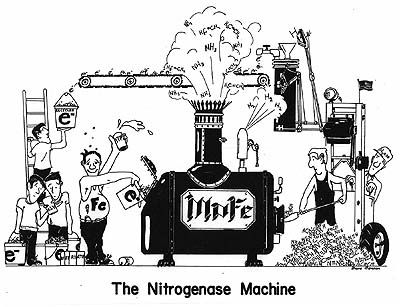
Vesicles are the site of N2-fixation in Frankia. Nitrogenase reduces N2 using electrons and ATP from compounds donated by the plant (these are unknown but pyruvate or succinate are possibilities). The product ammonia is most likely excreted from the vesicle where plant enzymes (GS) convert it to organic nitrogen (glutamine) (Benson and Brooks, 2016).
All Frankia strains tested make "vesicles" in N-deficient culture, and often in symbiosis. Vesicle structure is described here. The compartmentation of N2 fixation to the vesicle interior provides the enzyme with an anaerobic environment (Berry et al., 1993; Harriott et al, 1993; Parsons et al., 1987). All nitrogenases described to date are O2-labile and thus only function anaerobically.
The process of nitrogen fixation requires lots of energy in the form of ATP (12-24 ATP per N2 fixed), reducing power from central metabolism and nitrogen gas (N2).

The enzymatic reactions leading from N2 to metabolically useful amino acids are as follows:
Enzymes involved in nitrogen fixation and assimilation in Frankia |
|
| N2 +8 e- +8H++ (12-24) ATP -->2 NH4+ + H2 + (12-24 ADP + 12-24 Pi) | Nitrogenase |
| NH4+ + glutamate + ATP --> glutamine + ADP + Pi | Glutamine synthetase (GS) |
| Glutamine + α-ketoglutarate + NAD(P)H-->2 glutamate + NAD(P)+ | Glutamate synthase (GOGAT) |
The final product from the operation of the three enzymes nitrogenase, glutamine synthetase and glutamate synthase is glutamate, generally the most abundant free amino acid in bacterial cell cytoplasm.
Nitrogenase also produces hydrogen gas as part of its catalytic cycle. At least one H2 is produced per N2 reduced to ammonia. This represents a significant loss of energy. However, Frankia, like many other N2-fixing bacteria also has the enzyme hydrogenase that serves to recycle some of the electrons lost in H2. ATP is recovered if those electrons are reintroduced into the electron transport chain (shown in the cartoon above). An additional benefit is that O2 serves as the final electron acceptor in the so-called oxyhydrogen reaction, leading to the potential recovery of ATP and the lowering of ambient O2 levels